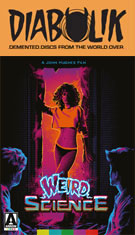
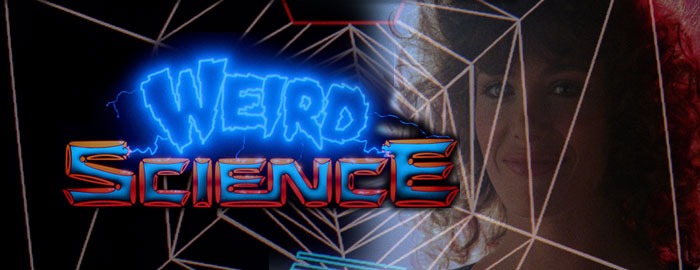
Color, 1985, 94 mins. / 96 mins. 38 secs. / 94 mins. 6 secs.
Directed by John Hughes
Starring Anthony Michael Hall, Ilan Mitchell-Smith, Kelly LeBrock, Bill Paxton, Suzanne Snyder, Judie Aronson, Robert Downey Jr., Robert Rusler, Vernon Wells, Michael Berryman
Arrow Video (Blu-ray) (US/UK RA/RB HD), Universal (Blu-ray & DVD) (US R0 HD/NTSC) / WS (1.85:1) (16:9)
After 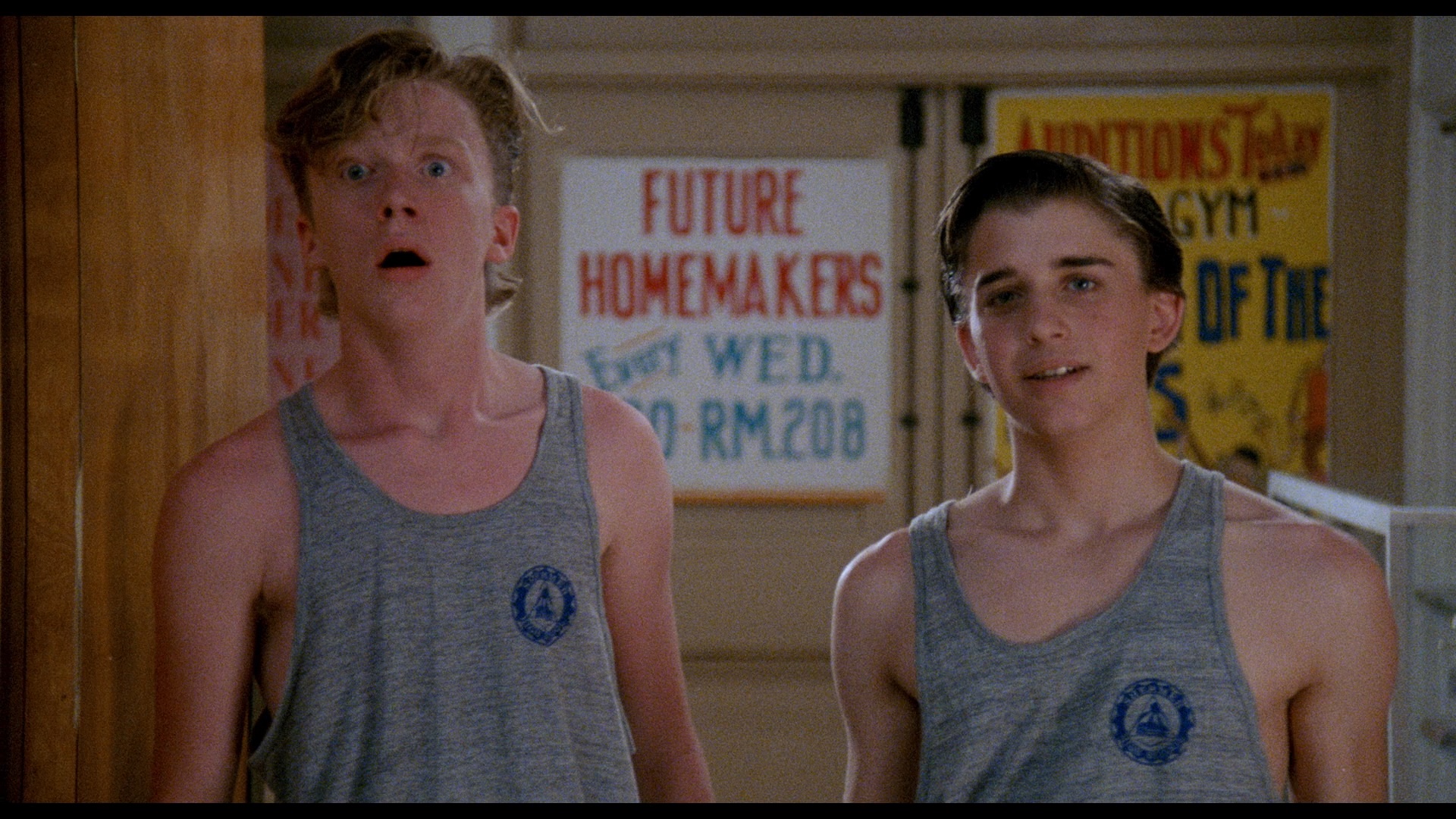 the surprise success of the teen comedy
the surprise success of the teen comedy 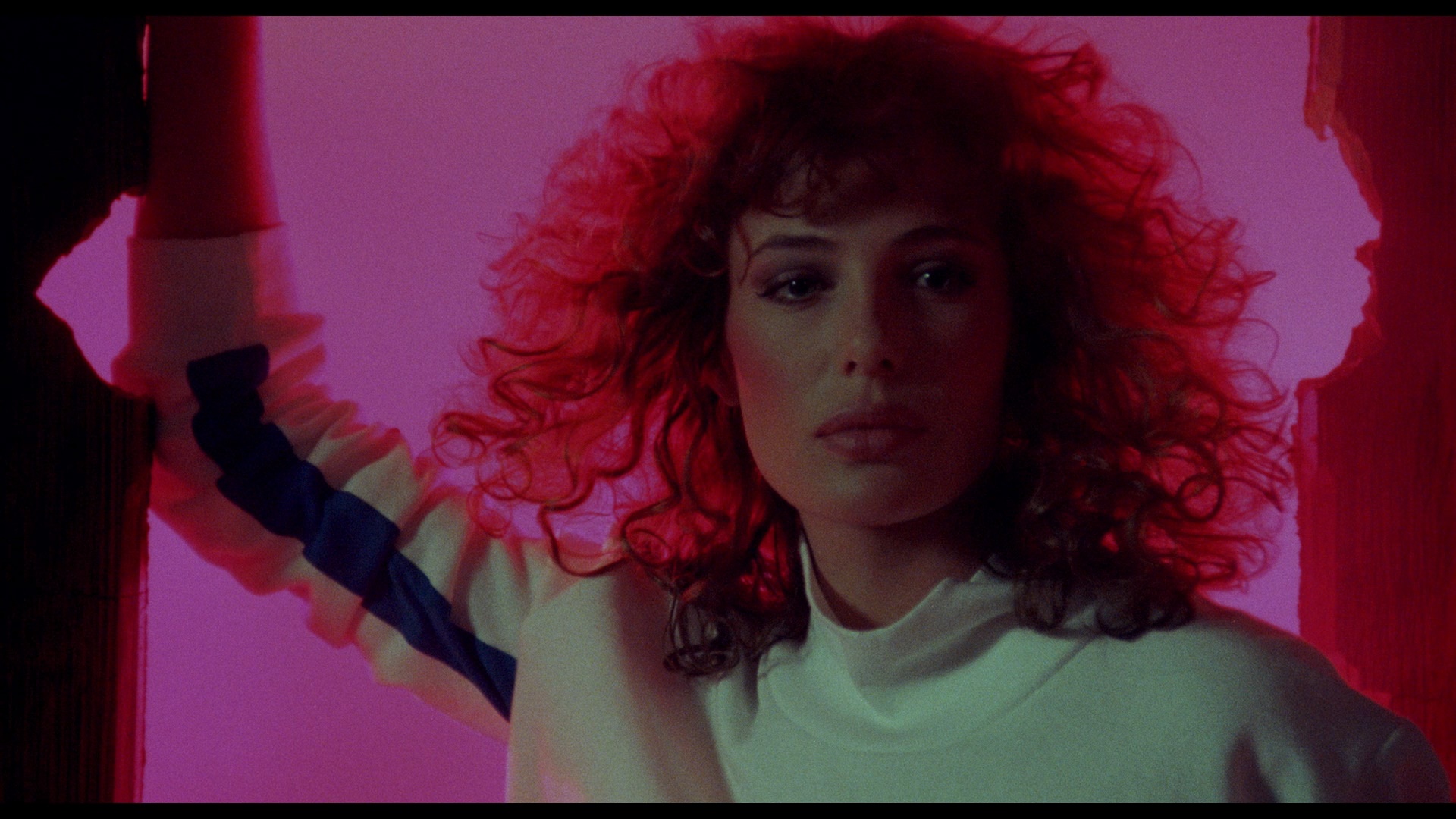 classic Sixteen Candles in 1984 and his earlier screenplay for the hit National Lampoon's Vacation a year before, John Hughes found himself at the top of the Hollywood heap with no less than three projects coming out in theaters in 1985. The most famous of these by far came first with The Breakfast Club at the beginning of the year, followed by two films that summer, National Lampoon's European Vacation (which he only wrote) and the strangest film in his teen cycle, Weird Science. Essentially taking a concept straight out of a '70s softcore film and grafting it onto a PG-13 horny teen sci-fi fantasy, Weird Science wasn't a favorite with critics and would never, ever fly in Hollywood today; however, that also makes it something of a wild time capsule and, perhaps accidentally, an oddly subversive take on male adolescent fantasies.
classic Sixteen Candles in 1984 and his earlier screenplay for the hit National Lampoon's Vacation a year before, John Hughes found himself at the top of the Hollywood heap with no less than three projects coming out in theaters in 1985. The most famous of these by far came first with The Breakfast Club at the beginning of the year, followed by two films that summer, National Lampoon's European Vacation (which he only wrote) and the strangest film in his teen cycle, Weird Science. Essentially taking a concept straight out of a '70s softcore film and grafting it onto a PG-13 horny teen sci-fi fantasy, Weird Science wasn't a favorite with critics and would never, ever fly in Hollywood today; however, that also makes it something of a wild time capsule and, perhaps accidentally, an oddly subversive take on male adolescent fantasies.
In the usual Hughes stomping grounds of Shermer, Illinois, two teen boys, Gary (Hall) and Wyatt (Mitchell-Smith), are constantly bullied and taunted at school, mostly by the idiotic Ian (Downey Jr.) and Max (Rusler). One night during a sleepover at Wyatt's during a viewing of Frankenstein, Gary comes up with the idea of using a computer to generate a virtual female they can ask questions about how to succeed with the opposite sex. However, a freak accident during the process ends up siphoning massive amounts of power from the area and ends up creating a flesh and blood woman they decide to name Lisa (LeBrock). Cheerful, outgoing, sexy, and intelligent, Lisa pushes the boys to break through their social barriers, first by going to a nightclub where they end up getting wasted and then throwing a wild house party that goes way out of control. They also have to contend with Wyatt's abusive doofus brother, Chet (Paxton), Gary's uptight parents, and a request to repeat their miraculous computer feat that can only lead to more mayhem. 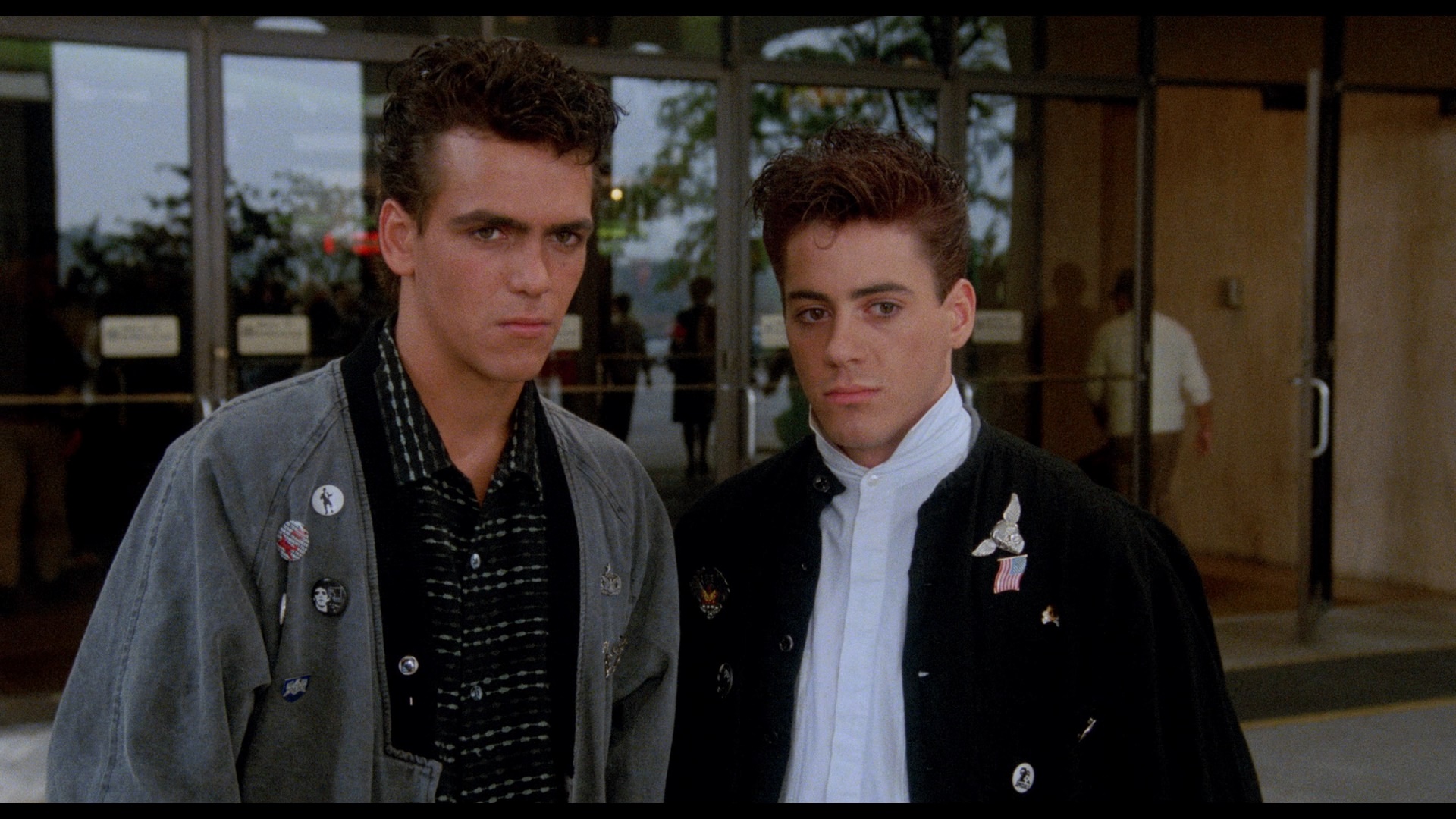
Boasting one of the catchiest theme songs of the decade (thanks to Oingo Boingo), Weird Science feels tailor made for cable TV where viewers could jump into the episodic story without  missing a whole lot in the process. It's also surprisingly ahead of its time as it points to future breakthroughs like online pornography, 3D printing, and the ascension of nerd culture into the mainstream. It's also a very vivid snapshot of mid-'80s movie attitudes from its clothing to its humor, which goes so broad and unrealistic that it can tend to rub some viewers the wrong way. That's especially true of the raucous party sequence, which even manages to work in wild roles for The Road Warrior's Vernon Wells and The Hills Have Eyes' Michael Berryman doing what they do best. However, this is really LeBrock's film all the way; she manages to take what should be an essentially unplayable character and breathes a welcome sense of liberation and authority into what might have been a flat sex object conceit in different hands.
missing a whole lot in the process. It's also surprisingly ahead of its time as it points to future breakthroughs like online pornography, 3D printing, and the ascension of nerd culture into the mainstream. It's also a very vivid snapshot of mid-'80s movie attitudes from its clothing to its humor, which goes so broad and unrealistic that it can tend to rub some viewers the wrong way. That's especially true of the raucous party sequence, which even manages to work in wild roles for The Road Warrior's Vernon Wells and The Hills Have Eyes' Michael Berryman doing what they do best. However, this is really LeBrock's film all the way; she manages to take what should be an essentially unplayable character and breathes a welcome sense of liberation and authority into what might have been a flat sex object conceit in different hands.
Weird Science has had a very uneven history on home video right from the beginning when its VHS release from Universal was doctored to replace some songs on the soundtrack (a fate that also befell everything from Sixteen Candles and Fast Times at Ridgemont High to The Thing). The music issues were eventually straightened out when the film hit DVD from Image Entertainment in 1999 and then Universal in 2003 (including the reinstating of "Oh, Pretty Woman" to one standout moment), with the latter adding the trailer and a retrospective featurette, "It's Alive! Resurrecting Weird Science" (16m41s) with Hall and actor John Kapelos, costume designer Marilyn Vance, along with admirers like Diablo Cody, Amy Heckerling, Northwestern University's Jeffrey Sconce and journalists Hank Stuever and Owen Glieberman chatting about the film as a startling change of pace after his two prior, 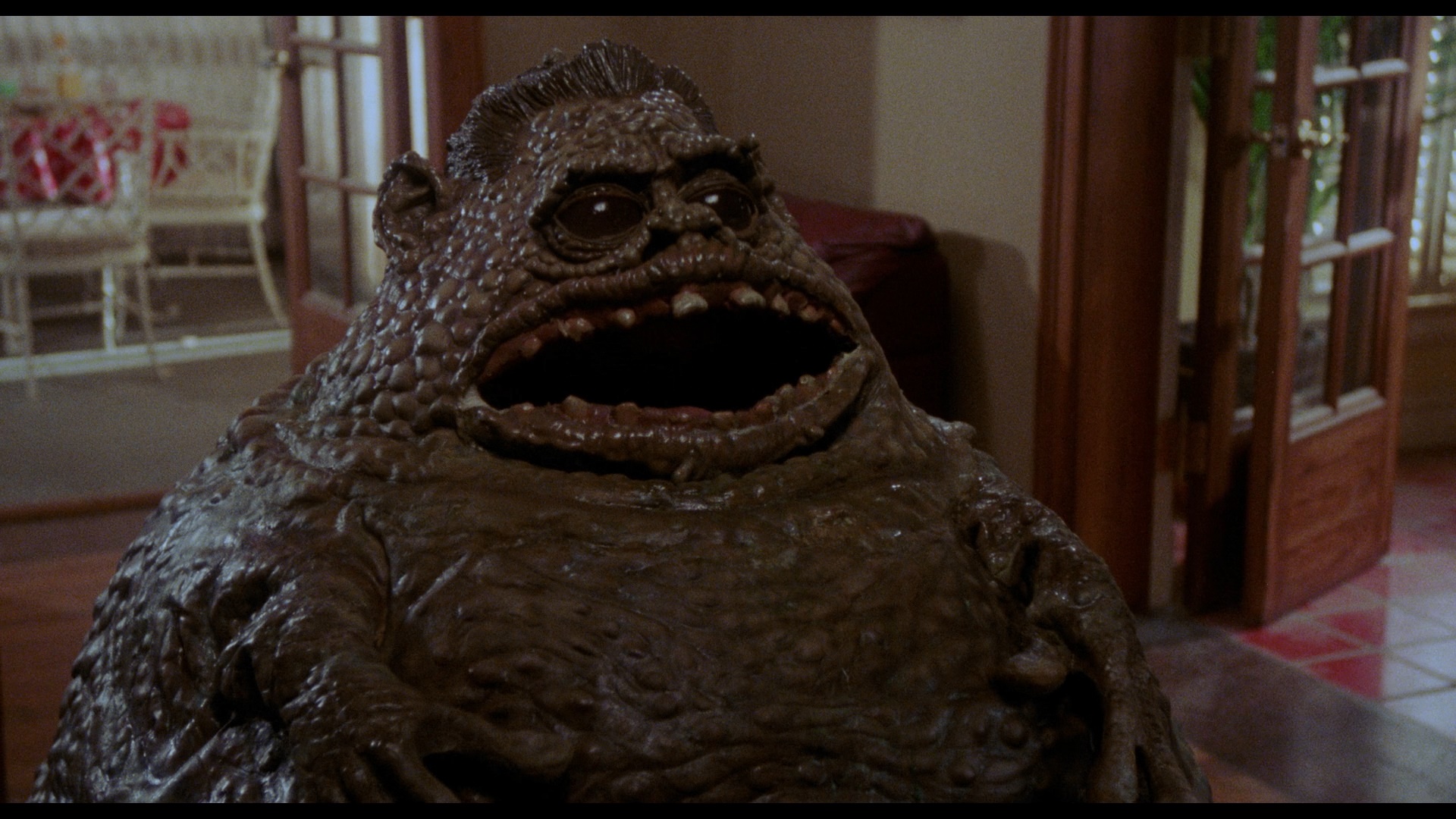 more grounded films with a heavy focus on fantastic elements and a release of its creator's id. Unfortunately the transfer originally crafted for HD broadcast and used on the DVD looked
more grounded films with a heavy focus on fantastic elements and a release of its creator's id. Unfortunately the transfer originally crafted for HD broadcast and used on the DVD looked 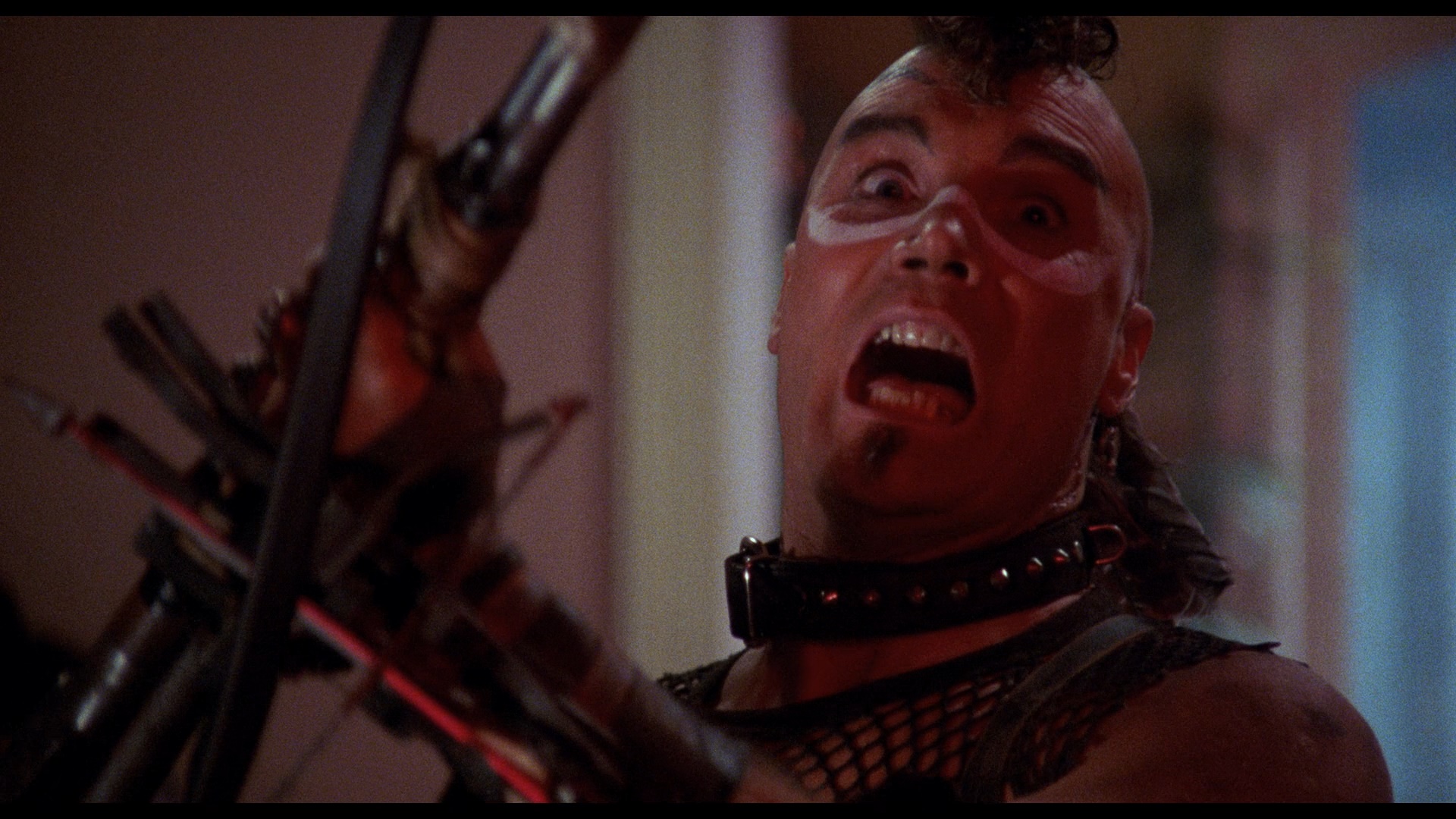 downright painful by the time it hit Blu-ray in 2013; loaded with heavy digital processing, it ranked near the bottom of Universal's spotty record with catalog titles and screamed out for a decent remastering.
downright painful by the time it hit Blu-ray in 2013; loaded with heavy digital processing, it ranked near the bottom of Universal's spotty record with catalog titles and screamed out for a decent remastering.
Fortunately Arrow Video came to the rescue in 2019 with a Blu-ray edition released in both the U.S. and U.K., boasting a new restoration from a 4K scan of the original negative. Every single thing about it is a massive improvement; film grain finally looks organic, colors look vivid but perfectly defined, and the details of things like clothing textures and hair are perfectly sharp without any nasty processing or edge enhancement. The film can be played with either its DTS-HD MA 2.0 theatrical stereo version or a 5.1 option, which spreads some sound effects to the rear speakers (especially the lead-up to LeBrock's entrance) but works just fine either way. Optional English SDH subtitles are also included. In a nice touch, you can also watch the film in an extended version reinstating three short scenes included in the TV version (now running 96m38s versus 94m) consisting of Gary expounding on Dawn of the Dead, an extra chat about Frankenstein in the kitchen as the boys come up with their plan, and the arrival of some Devo lookalikes at the party. The extended version is stereo only and looks the same quality-wise since it's created via seamless branching. Those extra scenes can also be watched separately (2m45s), and a third option is the inclusion of the toned-down version created for TV broadcast in SD (94m6s), which features those extra scenes along with a heavy amount of editing and alternate dialogue to make it palatable for general broadcast. The differences between the theatrical and TV versions are also highlighted in a side-by-side comparison reel (18m16s). The "It's Alive" featurette is carried over, but you also get five new featurettes shedding more light on the film's creating. "Casting 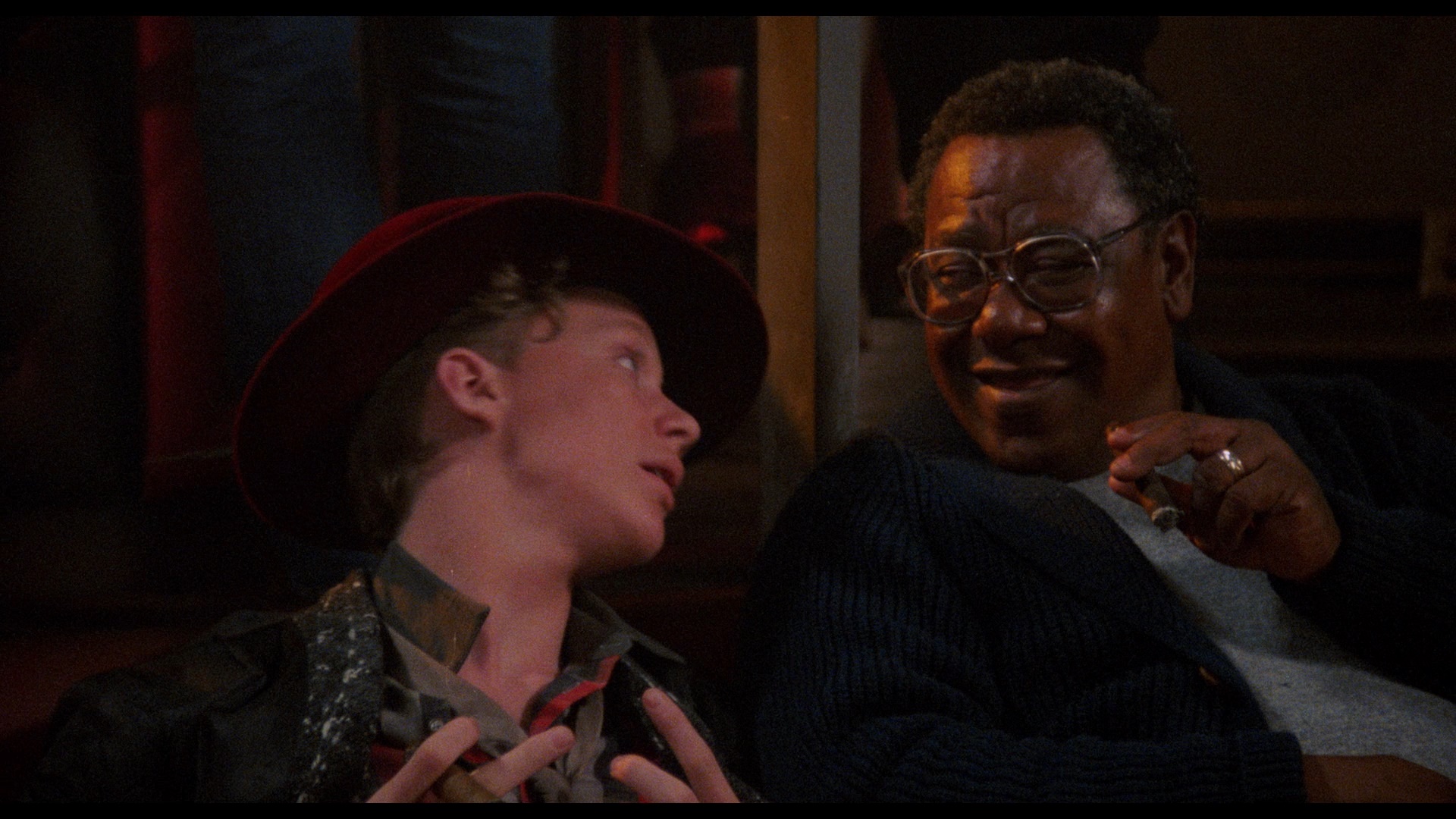 Weird Science" (6m3s) with casting director Jackie Burch is an interesting look at how the cast was assembled, including options like Robin Wright and Sharon Stone who were up for LeBrock's part. "Dino the Greek" (6m55s) catches up with Kapelos, something of a lucky charm in
Weird Science" (6m3s) with casting director Jackie Burch is an interesting look at how the cast was assembled, including options like Robin Wright and Sharon Stone who were up for LeBrock's part. "Dino the Greek" (6m55s) catches up with Kapelos, something of a lucky charm in  Hughes movies at the time, recalling how he appalled his mother with a Greek swear word in the film and shot much of the film in Hollywood despite the setting outside of Chicago. Then special makeup creator Craig Reardon appears in "Chet Happens" (19m38s) to discuss the bumpy process of how he got hired, the work he did on this that dovetailed with The Goonies, and the creation of the unforgettable "Chet blob" which entailed doing a lengthy cast process on an anxious Paxton. In "Fantasy and Microchips" (10m46s), editor Chris Lebenzon chats about his entry into the business via Francis Ford Coppola and his transition to Universal where he ended up joining forces with Hughes. Most interestingly, he explains how the ending came about after a more melancholy resolution as originally intended. Finally, "Ira Newborn Makes the Score" (13m43s) features Hughes' signature composer conversing about the tight time schedules at the time and the methods of writing orchestral music for films so heavily dominated by songs, including the creation of a main title theme that ended up being replaced by the now-iconic theme song. Finally you get the theatrical trailer, a surreal collage-style teaser (which has an odd Videodrome-style feel), a pair of TV spots, a hefty batch of radio spots (4m50s), and separate galleries for the shooting script (which is quite different in spots including opening up with those of those additional scenes and ending with a very dark fate for Chet), production stills, and poster and video art. The packaging also comes with new artwork by Tracie Ching and, in the first pressing only, an insert booklet with liner notes by Alexandra Heller-Nicholas and Amanda Reyes.
Hughes movies at the time, recalling how he appalled his mother with a Greek swear word in the film and shot much of the film in Hollywood despite the setting outside of Chicago. Then special makeup creator Craig Reardon appears in "Chet Happens" (19m38s) to discuss the bumpy process of how he got hired, the work he did on this that dovetailed with The Goonies, and the creation of the unforgettable "Chet blob" which entailed doing a lengthy cast process on an anxious Paxton. In "Fantasy and Microchips" (10m46s), editor Chris Lebenzon chats about his entry into the business via Francis Ford Coppola and his transition to Universal where he ended up joining forces with Hughes. Most interestingly, he explains how the ending came about after a more melancholy resolution as originally intended. Finally, "Ira Newborn Makes the Score" (13m43s) features Hughes' signature composer conversing about the tight time schedules at the time and the methods of writing orchestral music for films so heavily dominated by songs, including the creation of a main title theme that ended up being replaced by the now-iconic theme song. Finally you get the theatrical trailer, a surreal collage-style teaser (which has an odd Videodrome-style feel), a pair of TV spots, a hefty batch of radio spots (4m50s), and separate galleries for the shooting script (which is quite different in spots including opening up with those of those additional scenes and ending with a very dark fate for Chet), production stills, and poster and video art. The packaging also comes with new artwork by Tracie Ching and, in the first pressing only, an insert booklet with liner notes by Alexandra Heller-Nicholas and Amanda Reyes.
Reviewed on June 30, 2019



 the surprise success of the teen comedy
the surprise success of the teen comedy  classic Sixteen Candles in 1984 and his earlier screenplay for the hit National Lampoon's Vacation a year before, John Hughes found himself at the top of the Hollywood heap with no less than three projects coming out in theaters in 1985. The most famous of these by far came first with The Breakfast Club at the beginning of the year, followed by two films that summer, National Lampoon's European Vacation (which he only wrote) and the strangest film in his teen cycle, Weird Science. Essentially taking a concept straight out of a '70s softcore film and grafting it onto a PG-13 horny teen sci-fi fantasy, Weird Science wasn't a favorite with critics and would never, ever fly in Hollywood today; however, that also makes it something of a wild time capsule and, perhaps accidentally, an oddly subversive take on male adolescent fantasies.
classic Sixteen Candles in 1984 and his earlier screenplay for the hit National Lampoon's Vacation a year before, John Hughes found himself at the top of the Hollywood heap with no less than three projects coming out in theaters in 1985. The most famous of these by far came first with The Breakfast Club at the beginning of the year, followed by two films that summer, National Lampoon's European Vacation (which he only wrote) and the strangest film in his teen cycle, Weird Science. Essentially taking a concept straight out of a '70s softcore film and grafting it onto a PG-13 horny teen sci-fi fantasy, Weird Science wasn't a favorite with critics and would never, ever fly in Hollywood today; however, that also makes it something of a wild time capsule and, perhaps accidentally, an oddly subversive take on male adolescent fantasies. 
 missing a whole lot in the process. It's also surprisingly ahead of its time as it points to future breakthroughs like online pornography, 3D printing, and the ascension of nerd culture into the mainstream. It's also a very vivid snapshot of mid-'80s movie attitudes from its clothing to its humor, which goes so broad and unrealistic that it can tend to rub some viewers the wrong way. That's especially true of the raucous party sequence, which even manages to work in wild roles for The Road Warrior's Vernon Wells and The Hills Have Eyes' Michael Berryman doing what they do best. However, this is really LeBrock's film all the way; she manages to take what should be an essentially unplayable character and breathes a welcome sense of liberation and authority into what might have been a flat sex object conceit in different hands.
missing a whole lot in the process. It's also surprisingly ahead of its time as it points to future breakthroughs like online pornography, 3D printing, and the ascension of nerd culture into the mainstream. It's also a very vivid snapshot of mid-'80s movie attitudes from its clothing to its humor, which goes so broad and unrealistic that it can tend to rub some viewers the wrong way. That's especially true of the raucous party sequence, which even manages to work in wild roles for The Road Warrior's Vernon Wells and The Hills Have Eyes' Michael Berryman doing what they do best. However, this is really LeBrock's film all the way; she manages to take what should be an essentially unplayable character and breathes a welcome sense of liberation and authority into what might have been a flat sex object conceit in different hands.  more grounded films with a heavy focus on fantastic elements and a release of its creator's id. Unfortunately the transfer originally crafted for HD broadcast and used on the DVD looked
more grounded films with a heavy focus on fantastic elements and a release of its creator's id. Unfortunately the transfer originally crafted for HD broadcast and used on the DVD looked  downright painful by the time it hit Blu-ray in 2013; loaded with heavy digital processing, it ranked near the bottom of Universal's spotty record with catalog titles and screamed out for a decent remastering.
downright painful by the time it hit Blu-ray in 2013; loaded with heavy digital processing, it ranked near the bottom of Universal's spotty record with catalog titles and screamed out for a decent remastering.  Weird Science" (6m3s) with casting director Jackie Burch is an interesting look at how the cast was assembled, including options like Robin Wright and Sharon Stone who were up for LeBrock's part. "Dino the Greek" (6m55s) catches up with Kapelos, something of a lucky charm in
Weird Science" (6m3s) with casting director Jackie Burch is an interesting look at how the cast was assembled, including options like Robin Wright and Sharon Stone who were up for LeBrock's part. "Dino the Greek" (6m55s) catches up with Kapelos, something of a lucky charm in  Hughes movies at the time, recalling how he appalled his mother with a Greek swear word in the film and shot much of the film in Hollywood despite the setting outside of Chicago. Then special makeup creator Craig Reardon appears in "Chet Happens" (19m38s) to discuss the bumpy process of how he got hired, the work he did on this that dovetailed with The Goonies, and the creation of the unforgettable "Chet blob" which entailed doing a lengthy cast process on an anxious Paxton. In "Fantasy and Microchips" (10m46s), editor Chris Lebenzon chats about his entry into the business via Francis Ford Coppola and his transition to Universal where he ended up joining forces with Hughes. Most interestingly, he explains how the ending came about after a more melancholy resolution as originally intended. Finally, "Ira Newborn Makes the Score" (13m43s) features Hughes' signature composer conversing about the tight time schedules at the time and the methods of writing orchestral music for films so heavily dominated by songs, including the creation of a main title theme that ended up being replaced by the now-iconic theme song. Finally you get the theatrical trailer, a surreal collage-style teaser (which has an odd Videodrome-style feel), a pair of TV spots, a hefty batch of radio spots (4m50s), and separate galleries for the shooting script (which is quite different in spots including opening up with those of those additional scenes and ending with a very dark fate for Chet), production stills, and poster and video art. The packaging also comes with new artwork by Tracie Ching and, in the first pressing only, an insert booklet with liner notes by Alexandra Heller-Nicholas and Amanda Reyes.
Hughes movies at the time, recalling how he appalled his mother with a Greek swear word in the film and shot much of the film in Hollywood despite the setting outside of Chicago. Then special makeup creator Craig Reardon appears in "Chet Happens" (19m38s) to discuss the bumpy process of how he got hired, the work he did on this that dovetailed with The Goonies, and the creation of the unforgettable "Chet blob" which entailed doing a lengthy cast process on an anxious Paxton. In "Fantasy and Microchips" (10m46s), editor Chris Lebenzon chats about his entry into the business via Francis Ford Coppola and his transition to Universal where he ended up joining forces with Hughes. Most interestingly, he explains how the ending came about after a more melancholy resolution as originally intended. Finally, "Ira Newborn Makes the Score" (13m43s) features Hughes' signature composer conversing about the tight time schedules at the time and the methods of writing orchestral music for films so heavily dominated by songs, including the creation of a main title theme that ended up being replaced by the now-iconic theme song. Finally you get the theatrical trailer, a surreal collage-style teaser (which has an odd Videodrome-style feel), a pair of TV spots, a hefty batch of radio spots (4m50s), and separate galleries for the shooting script (which is quite different in spots including opening up with those of those additional scenes and ending with a very dark fate for Chet), production stills, and poster and video art. The packaging also comes with new artwork by Tracie Ching and, in the first pressing only, an insert booklet with liner notes by Alexandra Heller-Nicholas and Amanda Reyes.